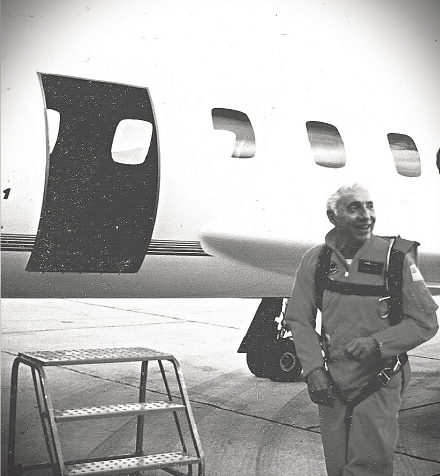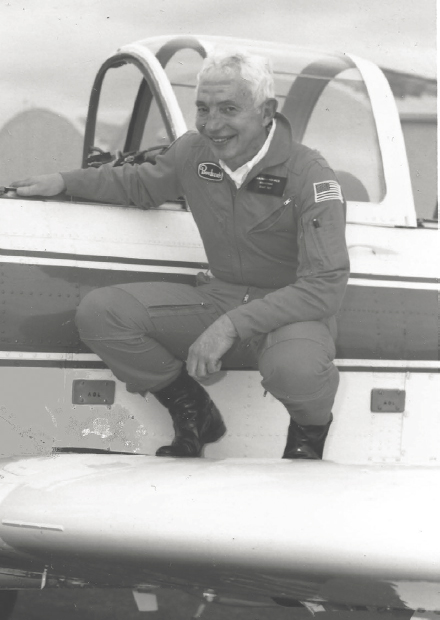

D. BRAINERD HOLMES
1921–2013
Elected in 1977
“Contributions to large electronic systems and leadership in manned space flight and industrial management.”
SUBMITTED BY THE NAE HOME SECRETARY
DYER BRAINERD HOLMES, NASA’s first director of manned spaceflight, former president of Raytheon, and retired chair of Beech Aircraft, died January 11, 2013, at age 91.
He was born May 24, 1921, in Brooklyn, New York. He prepared for college by attending Carteret Academy and Newark Academy in New Jersey and graduated from Cornell University in 1943 with a BS degree in electronic engineering. In 1943–44, as an ensign in the US Naval Reserve, he completed graduate studies in radar at both Massachusetts Institute of Technology and Bowdoin College. He was later awarded an honorary doctor of science degree from the University of New Mexico (1963) and an honorary doctor of engineering degree from Worcester Polytechnic Institute (1978).
Upon completion of his military service he worked at Bell Telephone Laboratories and Western Electric Company (1945–53), during which time he developed advanced repeaters, amplifiers, and measuring equipment. He then went to work at RCA (1953–61), where he rose to become general manager of the Major Defense Systems Division, responsible for a federally sponsored project to design and implement the Air Force’s Ballistic Missile Early Warning System (BMEWS), with radar installations in Alaska, Greenland, and the United Kingdom. This system protected
the United States and allies for over 4 decades, one of the longest running and most successful Cold War projects. At RCA he also oversaw the development of the Talos antiaircraft missile system and the launch control and checkout equipment for the Atlas missile system.
Based on his accomplishments in the private sector, he attracted the attention of NASA and became director of its Office of Manned Space Flight (OMSF) in October 1961. He led the national effort to go to the moon and directed NASA’s other efforts in manned spaceflight; among other things he explored options for a new heavy-lift launch vehicle to meet the president’s goal.
A brilliant engineer, Mr. Holmes was instrumental in tackling the practicalities of President John F. Kennedy’s challenge of putting a man on the moon by 1970. He was so influential in the Apollo era that he was featured on the cover of Time magazine (August 10, 1962) as the agency’s “Space Planner.” He was quoted in the cover story, “When a great nation is faced with a technological challenge, it has to accept or go backward. Space is the future of man, and the US must keep ahead in space.” Mr. Holmes adhered to this edict and continued to revolutionize the aerospace industry throughout his career.
In December 1961 he raised the issue of orbital rendezvous in his outline of an expanded version of the Mercury capsule, formally named “Project Gemini.” The project focused on mastering orbital rendezvous and docking, long-duration flight, controlled land recoveries, and astronaut training.
In October 1962 he was appointed NASA deputy associate administrator, while continuing to direct OMSF; all NASA field installations dealing with manned space flight issues reported directly to him. In April 1963 he urged Congress to increase spending on the Gemini program because of its ambitious technical goals, including new transmission equipment to handle higher data rates, a more reliable rendezvous radar, and a heavily modified environmental control system. He also called on NASA to streamline its management structure, improve internal communications, and determine the method it would use to reach the moon.
When Neil Armstrong and Buzz Aldrin landed on the moon in 1969, Holmes told the New York Times “we should remember such endeavors as these and know that when given a challenge Americans today can be as hard, as aggressive, and as brave as the men who founded this land.”
In September 1963 he left NASA to become a director at Raytheon, managing its military engineering, research, and development. In 1975 he was named president, and when Raytheon acquired Beech Aircraft in 1982 he also became chair of that company. His engagement with aircraft extended far beyond the traditional role of CEO; as a commercial-rated pilot, he logged over 4500 hours in a variety of aircraft, including jets, and as a test pilot of experimental aircraft. When he retired from Raytheon in 1986, the company’s annual sales during his tenure had grown to $7.3 billion.
Beyond his professional career, he served on boards for many companies and philanthropies, including the MITRE Corporation, Smithsonian National Museum of Natural History, Bank of Boston (16 years), Wyman-Gordon Company (Worcester, MA; 20 years), and Kaman Corporation (Bloomfield, CT; 20 years).
Holmes received a 1963 NASA Medal for “his outstanding leadership of the manned space flight program during the formative period of Project Apollo and for his imaginative and energetic leadership in forging a manned space flight organization dedicated to advancing the United States toward its goal of preeminence in space,” as well as the Arnold Air Society’s Paul T. Johns Award for outstanding contributions to aeronautics and astronautics.
He was a member of the National Academy of Engineering and a fellow of the American Institute of Aeronautics and Astronautics and Institute of Electrical and Electronics Engineers. He was also a member of the engineering honor societies Eta Kappa Nu and Tau Beta Pi.
A lifelong Episcopalian, Mr. Holmes was a parishioner of St. Paul’s Church on Nantucket.
His marriage to Dorothy Bonnet Holmes ended in divorce and his second wife, Roberta Donohue (Bobbie) Holmes, died
in 1999. In 2002 he married Mary Margaret England Wilkes; they lived in Wellesley, Massachusetts. She survives him, as do daughters Katherine Holmes Kobos (Michael) and Dorothy “Pixie” Holmes Kather; stepson Scott Pierce Ledbetter Jr. (Margaret O’Connor); stepdaughters Baylor Ledbetter Stovall (Howard) and Margaret Ledbetter Weaver (Jock); six grandchildren; and seven great-grandchildren.






